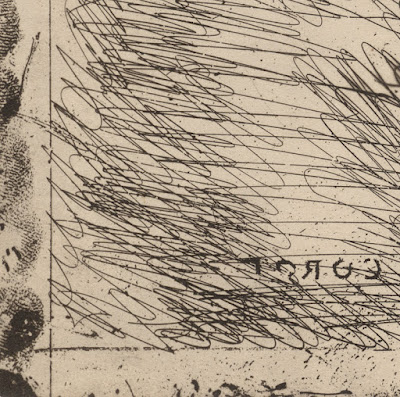Jean-Baptiste Camille Corot (1796–1875)
“Souvenir of
Ostia”, 1855, from the series of cliché
verre prints, “Quarante Cliché-Glaces”, printed in the Le Garrec 1921 edition
with Le Garrec’s ink stamp verso.
Point drawn
cliché verre on fine light sensitive wove paper, signed by the artist in
reverse (lower left)
Size: (sheet)
28.9 x 36.1 cm; (image borderline) 27.2 x 34.4 cm
Delteil 57;
Melot 57
The British
Museum offers the following description of this print:
“Plate 13:
landscape (Ostia?) with church(?) building amongst trees, figure in foreground
beside stream; first plate; from a portfolio of forty mounted cliché-verre
prints by five artists.” (http://www.britishmuseum.org/research/collection_online/collection_object_details.aspx?objectId=1341285&partId=1&searchText=corot+Ostia&page=1)
Condition:
superb impression in pristine condition by Le Garrec with verification stamp of
authenticity (verso).
I am selling this large original print by,
Corot, one of the most famous artists of the 19th century, for a
total cost of AU$986 (currently US$759.74/EUR678.07/GBP582.06 at the time of
this listing) including postage and handling to anywhere in the world.
If you are
interested in purchasing this exceedingly rare cliché verre print (i.e. a
drawing inscribed through an opaque emulsion applied to a glass plate that is
then placed over a sheet of light sensitive paper and exposed original glass
print using a photographic process on light please contact me
(oz_jim@printsandprinciples.com) and I will send you a PayPal invoice to make
the payment easy.
This print has been sold
One of the
seductive attributes of making cliché-verre prints (i.e. “a print made by
placing photographic paper beneath a glass plate on which a design has been
scratched through a coating of an opaque substance and then exposing it to
light” [https://www.britannica.com/art/cliche-verre])
is the relative ease with which an inscribing instrument can glide over the
glass plate. Corot is clearly liberated by the process, as his line work in
this print is freely laid. Corot’s approach to achieving tonal variation using
this process is the same that employed by pen-and-ink artists who only use
full-strength ink: Corot compacts his line work in areas of shadow and varies
the amount of white paper left between each stroke to represent different
intensities of light.
Regarding the “Quarante
Cliché-Glaces” series of cliché verre prints that this large and exceedingly rare
print was extracted, the curator of the British Museum offers the following
information:
“From a
portfolio of forty individually mounted cliché-verre prints by Corot, Daubigny,
Delacroix, Millet and Rousseau, printed from plates held in the collection of
M. Cuvelier (Paris: Maurice Le Garrec, 1921); with title page, list of plates and
'avertissement', each mount and title page stamped with the series number in
blue ink; edition 8/150. The verso of each print also bears a stamp, possibly
that of the Edmond Sagot studio (the title page states that Le Garrec was the
successor to Sagot). The department also holds a cliché-verre plate by Corot (
) which was donated by M. Cuvelier after the printing of this series.” (http://www.britishmuseum.org/research/collection_online/collection_object_details.aspx?objectId=1341297&partId=1&searchText=1922,0410.213&page=1).





very informative thank you
ReplyDelete